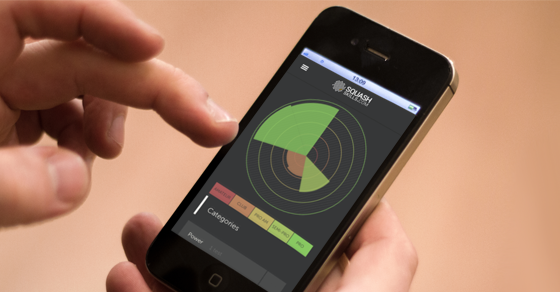The process of ‘goal-setting’ is an extremely useful mental training technique, that can help focus attention and effort when working toward a targeted personal goal.
Used by high achievers across a range of fields from business high-flyers to elite athletes, goal-setting is an excellent tool to enhance adherence and motivation along the way when working toward a desired outcome – for the squash player it’s a great way to formulate long-term targets for their game, and to consider the necessary steps that are needed to get there.
There are two basic types of goals – outcome goals and process goals. Outcome goals are the end result, things like winning certain matches/tournaments, reaching particular ranking levels, or being selected for specific competitive teams and squads. Process/performance goals on the other hand, are the specific actions, behaviours, moods, and mental processes required to achieve the desired outcomes.
Longer-term goals are frequently more outcome-based, but it is the shorter term day-to-day process goals that ultimately put you in position to actually achieve those outcome goals – think about where you want to be, and then what you need to do to get there. These process goals can help provide motivation even when your results might not be quite what you hoped – losing a game will obviously always be disappointing, but if you have a set goal of say hitting less than 6 unforced errors over the course of a match for example, then there are still positives you can extract and build upon.
Focusing on your process goals should be a particular priority during training sessions, and formulating these targets is a very useful method toward enhancing overall focus effort and attention in your training.

For goal-setting to be of greatest benefit however, it’s important the goals are put together in the most practical and effective format. To this end the acronym SMART was coined, to give a framework in which to formulate your goals.
SMART here stands for Specific, Measurable, Achievable, Realistic, and Timed, though there are other slight variations some people prefer.
SPECIFIC
Goals should be made as precise and detailed as possible. A goal for a squash player of ‘getting fitter’ for example is too vague, lacking the necessary level of specificity or clarity.
Be precise with what you want – think about what element of your game you want to work on, and identify exactly where you want to be with it. For the aforementioned fitness-themed goal, for example, a better goal would be to target reaching a specific bleep test level, or to work up to be able to squat a certain weight.
 Similarly, reaching a certain score on one of our SquashSkills skill tests for a particular shot would be a good specific goal, or another might be to reduce the easy points you give away by resolving to not make more than 3 unforced errors per game in your matches.
Similarly, reaching a certain score on one of our SquashSkills skill tests for a particular shot would be a good specific goal, or another might be to reduce the easy points you give away by resolving to not make more than 3 unforced errors per game in your matches.
MEASURABLE

Making goals measurable ties in with the initial SMART criteria of being specific. By first being specific with your goals relating to your desired areas for improvement, making them quantifiable allows you to then ascertain your current proficiency and set recordable, measurable targets that can be used to really gauge improvement.
Professional players setting long-term outcome goals will very often have a certain world ranking goal they’ve set to reach – an objective, measurable record of their achievements. Similarly, amateur players might set goals of reaching a certain box league within their club, winning a certain percentage of their matches within an inter-club league season, or being selected to play for a specific higher numbered team.
ACHIEVABLE
Goals should be challenging enough to spur you on, but not so broad and vast so as to be overwhelming. While long-term, outcome-based goals are an integral part of the goal-setting formula, it’s important to also break down smaller more immediately achievable goals to boost motivation and provide an ongoing sense of achievement.
Assess your current abilities and set goals enough beyond where you are to challenge yourself and make you want to work toward them, but not so far beyond your current ability so as you’re likely to get discouraged. Your long-term goal may be to win your club championships, but a more achievable set of goals that work toward this may be based around first working your way up the internal divisions of the leagues in your club.
REALISTIC
As much as goals are there to provide motivation towards achieving your highest sporting aspirations, it’s important also to be realistic both in timeframe and in scope. If a professional player ranked 100 in the world settled on a goal of reaching the world’s top 10 within 6 months, while technically possible, they’re setting themselves up for a fall by shooting too high.
Similarly for an amateur player, setting a goal of beating a higher ranked player from within your club by the end of the year is not really realistic if you’ve not even up until this point ever actually taken a game from them.
It’s important to aim high and shoot for the stars, but realism is important. To this end, working with a coach or close friend familiar with your game is a good route toward effective and realistic goal setting.
TIMED

Set a specific time or deadline for your goals. It’s easy to put off goals as ‘one day’, but it’s important to set a timeline for achieving each of your goals. Different goals will have different timelines, so setting short, medium, and long-term goals is great for maintaining motivation over time.
If your target is to play at number one for your club team, for example, set yourself a timeframe in which to complete that goal – this will help provide focus, and ensure you’re maintaining that little bit of pressure on yourself to keep working toward that goal.
Finally, it is important to actually go through the act of writing your goals down, even if there’s only a small amount of them. The process of writing them down is symbolic whilst also being practical, and can really help toward reinforcing your intent to complete them. It creates a contract with yourself that you feel obliged and committed to complete, particularly if you give yourself small ‘rewards’ for each achievement that you pass.
Once your SMART goals have been written out, put them somewhere you know you will often see them – it could be on a sheet of paper by your bedside table, on the home screen of your phone, or on the front page of your training diary. By keeping them visible and tangible, you’ll be frequently reminded of them, and they can then be monitored and ticked off as you go – keeping you focused and resolute on the path towards your most important long term squash playing goals.
Gary Nisbet
B.Sc.(Hons), CSCS, NSCA-CPT, Dip. FTST
SquashSkills Fitness & Performance Director
Sign up to the SquashSkills newsletter
Get world class coaching tips, straight to your inbox!